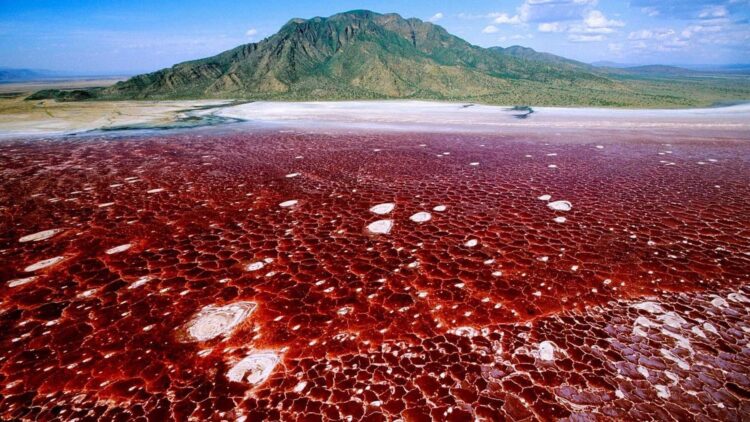In a remote corner of northern Tanzania, where the sun punishes with intensity and the landscape seems devoid of life, extends a surface as red as blood that seems to have been painted by ancient gods, even referred to as a kind of natural mummification. It is the saline lake of Natron, a body of water so hostile that it has even petrified birds such as flamingos, bathed in alkaline salts that transform biology into macabre art. Located on the African continent, this saline lake stands out for the great natural phenomena and its extreme ecosystem, you can even find caustic soda!
What at first glance might seem like the setting of a science fiction movie is actually one of the most extreme and at the same time most fascinating ecosystems on the planet. A place where life has found unsuspected ways to persist, defying all evolutionary logic. And it not only persists: it flourishes.
The red that comes from the invisible
The first glance upon arriving at Natron is visually overwhelming. In the dry season, its waters are dyed scarlet or deep pink, a phenomenon caused by millions of extremophile microorganisms – including spirulina – that not only survive, but thrive in conditions that would kill most terrestrial life forms. These microorganisms contain pigments that stain the water and, incidentally, the flamingos that feed on them.
Yes, the flamingos. Because if anything is even more unusual than the color of the lake, it is its function as a sanctuary for one of the most iconic species of the African continent: the lesser flamingo. Three out of four of these elegant pink birds are born here, in a habitat that seems designed to repel any predator.
During the day, the water temperature can exceed 60 degrees Celsius, and its pH is around 10.5, a figure that rivals that of bleach. Even so, the shores of the lake are filled with thousands, millions of flamingos that build their nests on small mounds of mud hardened by the salts. The extreme heat and salinity, far from being a threat to their young, are an impenetrable barrier to any intruder with bad intentions.
This seemingly hellish habitat thus becomes a reproductive oasis, a perfect example of how evolution selects the most unlikely paths to ensure survival. There are no lions or jackals here. Nor humans, beyond the intrepid travelers or scientists who dare to venture into its lunar geography.
Where water petrifies death
The legend of the lake that turns animals to stone has a real, though not magical, basis. The bodies of birds and other animals that accidentally fall into its waters are often coated by minerals that preserve them in an astonishingly intact state. They dry quickly, wings outstretched or eyes open, as if they had been struck by an African Medusa curse. These corpses do not dissolve: they are preserved as natural sculptures, as testimonies of an ecosystem that does not forgive mistakes.
A short distance from the lake rises Ol Doinyo Lengai, known as “the Mountain of God” by the Maasai people. This active volcano, the only one on the planet that expels natrocarbonatite lava – black as it flows, white as it cools – adds an almost mystical component to the whole. The lava flows like oil and solidifies forming figures that look like ghostly sculptures. From its summit, one can contemplate a landscape that seems not to belong to the Earth.
This link between the lake and the volcano is not only geographical, but also biological: the geothermal activity feeds the alkaline springs that flow into Natron, creating the perfect chemical broth for its extreme organisms.
An ecological jewel under threat
Despite its impenetrable appearance, Lake Natron is not safe. Proposals to build dams or mine minerals in the region have raised alarms among biologists and conservationists. Minimal changes in salinity or water levels could disrupt the delicate balance that makes the flamingo miracle possible.
For this reason, Tanzania declared Lake Natron a Ramsar site in 2001, on the list of wetlands of international importance. But threats persist, and with them the risk of losing one of the most unique and unknown environments on the planet.
However, beyond its ecological relevance, Natron is also a living laboratory for science. The ability of its microorganisms to survive in extreme conditions has aroused the interest of researchers studying possible extraterrestrial life forms. If life can thrive here, why not on a moon of Jupiter or on a distant exoplanet?
At the same time, its haunting beauty attracts photographers, explorers and alternative tourism enthusiasts looking for out-of-the-ordinary experiences. Although getting here involves traversing dirt tracks, sweltering heat and complicated logistics, those who make it there agree on one thing: the experience leaves a lasting impression.

